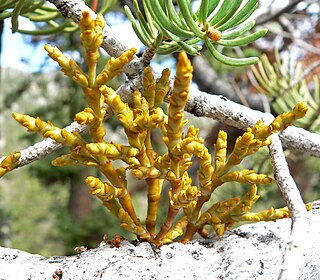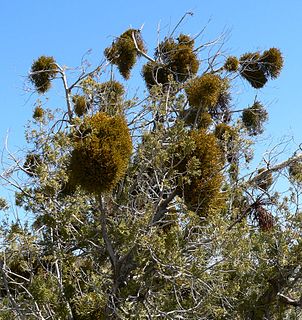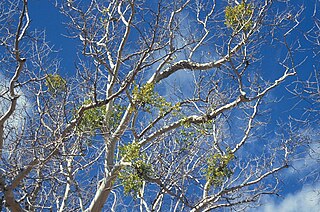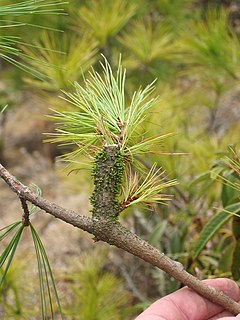
The Santalales are an order of flowering plants with a cosmopolitan distribution, but heavily concentrated in tropical and subtropical regions. It derives its name from its type genus Santalum (sandalwood). Mistletoe is the common name for a number of parasitic plants within the order.

Mistletoe is the common name for obligate hemiparasitic plants in the order Santalales. They are attached to their host tree or shrub by a structure called the haustorium, through which they extract water and nutrients from the host plant.

Loranthaceae, commonly known as the showy mistletoes, is a family of flowering plants. It consists of about 75 genera and 1,000 species of woody plants, many of them hemiparasites. The three terrestrial species are Nuytsia floribunda, Atkinsonia ligustrina, and Gaiadendron punctatum Loranthaceae are primarily xylem parasites, but their haustoria may sometimes tap the phloem, while Tristerix aphyllus is almost holoparasitic. For a more complete description of the Australian Loranthaceae, see Flora of Australia online., for the Malesian Loranthaceae see Flora of Malesia.

Phoradendron is a genus of mistletoe, native to warm temperate and tropical regions of the Americas. The center of diversity is the Amazon rainforest. Phoradendron is the largest genus of mistletoe in the Americas, and possibly the largest genus of mistletoes in the world. Traditionally, the genus has been placed in the family Viscaceae, but recent genetic research acknowledged by the Angiosperm Phylogeny Group shows this family to be correctly placed within a larger circumscription of the sandalwood family, Santalaceae.

A parasitic plant is a plant that derives some or all of its nutritional requirements from another living plant. They make up about 1% of angiosperms and are found in almost every biome. All parasitic plants have modified roots, called haustoria, which penetrate the host plant, connecting them to the conductive system – either the xylem, the phloem, or both. For example, plants like Striga or Rhinanthus connect only to the xylem, via xylem bridges (xylem-feeding). Alternately, plants like Cuscuta and Orobanche connect only to the phloem of the host (phloem-feeding). This provides them with the ability to extract water and nutrients from the host. Parasitic plants are classified depending on the location where the parasitic plant latches onto the host and the amount of nutrients it requires. Some parasitic plants can locate their host plants by detecting chemicals in the air or soil given off by host shoots or roots, respectively. About 4,500 species of parasitic plants in approximately 20 families of flowering plants are known.

Arceuthobium americanum is a species of dwarf mistletoe known as American dwarf mistletoe and lodgepole-pine dwarf mistletoe. It is a common plant of western North America where it lives in high elevation pine forests. It is a parasitic plant which lives upon the Lodgepole Pine, particularly the subspecies Pinus contortus ssp. murrayana, the Tamarack Pine. This pine subspecies is most common in the Cascade Range and Sierra Nevada. The American dwarf mistletoe is a yellow-green coral-shaped structure above the surface of the tree's bark, while most of the parasite is beneath the bark. The seeds mature in late summer and disperse to nearby trees. This species has been found to explosively-disperse its seeds through thermogenesis.

Arceuthobium abietinum is a species of dwarf mistletoe known as fir dwarf mistletoe. It is native to western North America from Washington to New Mexico to northern Mexico, where it lives in coniferous forests as a parasite on various species of fir, particularly white fir, giant fir, and red fir. This is a small shrub which is visible as a network of scaly yellowish stems extending above the bark of its host tree. Most of the mistletoe is located inside the host tree, attached to it via haustoria, which tap the tree for water and nutrients. The leaves of the mistletoe are reduced to knobby scales on its surface. It is dioecious, with male and female mistletoe plants producing spikes of staminate and pistillate flowers, respectively. The fruit is a sticky berry a few millimeters long which explodes to disperse the seeds it contains several meters away from the parent plant and its host tree.

Arceuthobium douglasii is a species of dwarf mistletoe known as Douglas fir dwarf mistletoe. It is native to western North America from British Columbia to Texas to California, where it lives in forest and woodland as a parasite. It is found mostly on Douglas fir trees, but occasionally on fir, as well.
Arceuthobium littorum is a species of dwarf mistletoe known as coastal dwarf mistletoe. It is endemic to the coastline of northern California, where it lives as a parasite on Bishop Pine and Monterey Pine trees. This is a dark brown or greenish shrub which is visible as a network of scaly stems extending above the bark of its host tree. Most of the mistletoe is located inside the host tree, attached to it via haustoria, which tap the tree for water and nutrients. The leaves of the mistletoe are reduced to scales on its surface.
Arceuthobium siskiyouense is a species of dwarf mistletoe known as knobcone pine dwarf mistletoe. It is endemic to the Klamath Mountains of northern California and southern Oregon, where it lives as a parasite on knobcone pine trees. This is a brownish shrub which is visible as a network of scaly stems extending above the bark of its host tree. Most of the mistletoe is located inside the host tree, attached to it via haustoria, which tap the tree for water and nutrients. The leaves of the mistletoe are reduced to scales on its surface.
Arceuthobium monticola is a species of dwarf mistletoe known as western white pine dwarf mistletoe. It is endemic to the Klamath Mountains of northern California and southern Oregon, where it lives as a parasite on western white pine trees.

Phoradendron juniperinum is a species of flowering plant in the sandalwood family known by the common name juniper mistletoe. It is native to the southwestern United States and northern Mexico, where it grows in various types of woodland habitat. It has been reported from California, Nevada, Arizona, New Mexico, Oregon, Utah, Texas, Chihuahua and Sonora.

Phoradendron macrophyllum is a species of flowering plant in the sandalwood family known by the common names Colorado Desert mistletoe, bigleaf mistletoe, and Christmas mistletoe. It is native to western United States and northern Mexico from Oregon to Colorado to Texas to Baja California, where it grows in many types of wooded habitat at elevations up to 1700 m.

Phoradendron tomentosum, the leafy mistletoe, hairy mistletoe or Christmas mistletoe, is a plant parasite. It is characterized by its larger leaves and smaller berries than dwarf mistletoe. Leafy mistletoe seldom kill but they do rob their hosts of moisture and some minerals, causing stress during drought and reducing crop productions on fruit and nut trees. Leafy mistletoe has the ability to photosynthesize on its own but it relies on other plants in order to obtain its nutrients. It attaches itself to a tree and then grows haustoria, in order to get the food and water it needs.
Arceuthobium apachecum, called the "Apache dwarf mistletoe," is a parasitic plant found on the branches of pine trees in Arizona, New Mexico and Coahuila. It has yellowish-green stems up to 7 cm high.
Arceuthobium microcarpum, called the "western spruce dwarf mistletoe," is a parasitic plant known only from Arizona and New Mexico. It is found mostly on spruce trees but also occasionally on Rocky Mountain bristlecone pine. The specific epithet "microcarpum" means "small fruited," in reference to the berries, which are only 3.5 mm long.

Arceuthobium pusillum is a perennial, obligate parasitic plant in the sandalwood family. Its common names include Dwarf mistletoe or Eastern dwarf mistletoe. It is one of the most widespread dwarf mistletoes within its range which covers the eastern United States and Canada, from Saskatchewan to Nova Scotia and New Jersey. The species name "pusillum" derives from Latin "pusillus", meaning very small.

Daniel Lee Nickrent is an American botanist, working in plant evolutionary biology, including the subdisciplines of genomics, phylogenetics, systematics, population genetics, and taxonomy. A major focus has been parasitic flowering plants, particularly of the sandalwood order (Santalales). His interest in photographic documentation and photographic databases has led to several photographic databases including Parasitic Plant Connection, Phytoimages, Plant Checklist for the Rocky Mountain National Park, and Plant Checklist for the Crab Orchard National Wildlife Refuge.

Arceuthobium minutissimum, known as the Indian dwarf mistletoe or Himalayan dwarf mistletoe, is a leafless parasitic plant of Pinus wallichiana. It is considered the smallest known dicotyledonous plant.
















